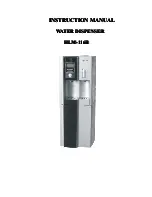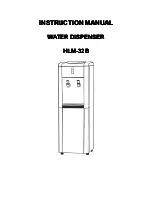
Trouble Shooting –
Concessionaire Dispensers
Beer Service Problems
■
Wild Beer
:
Dispensed beer has either too much foam or
is all foam.
C
AUSES
:
■
Beer has been dispensed improperly.
Solution: See pouring instructions
on page 8.
■
Regulator pressure is set too high.
■
Warm keg temperature.
Solution: Keg must be colder than
40°. Target temperature is between
36° and 38° F.
■
Cabinet door is opened and closed
frequently and temperature is warmer
than 38° F.
Solution: Adjust temperature to between
36° and 38° F.
■
Kinks, dents or obstructions in the line.
■
Using oddly shaped glasses. Frosted,
waxed or styrofoam containers may
cause foaming.
■
Dispenser has been turned off for a
long period of time.
■
Faucet is bad, dirty or in a worn condition.
■
Regulator malfunction.
■
Flat Beer:
Foamy head disappears quickly; beer lacks
brewery fresh flavor.
C
AUSES
:
■
Dirty glassware.
■
CO
2
pressure is too low, due to leak or
pressure setting.
■
CO
2
is turned off at night.
■
Cooler is too cold.
■
CO
2
leak or defective (sticking)
check valve.
■
Sluggish CO
2
regulator.
■
Cloudy Beer:
Beer in glass appears hazy, not clear.
C
AUSES
:
■
Dirty glass.
■
Dirty faucet or beer line.
■
Frozen or nearly frozen beer.
■
Old beer.
■
Beer that has not been refrigerated for a
long period of time.
Beer and CO
2
Facts
Keg
No. of
No. of
No. of
No. of
Full Keg
Size
Gallons
Oz.
Cases
12Oz. Weight
Servings
Quarter
7
3
⁄
4
992
3.445
105
87 lbs.
Half
15
1
⁄
2
1,984
6.889
210
161 lbs.
■
Beer foam is 25% liquid beer and 75% CO
2
gas. Don’t waste it!
■
Most people prefer beer stored at 38° F.
■
Beer lines and faucets require regular cleaning
(see cleaning instructions on page 7).
■
A fully-charged 4.2 lb. CO
2
cylinder will
dispense approximately 5
1
⁄
2
to 6
1
⁄
2
half barrels.
■
CO
2
gas gives beer its sparkling effervescence.
It also gives beer its creamy head of foam.
Form No. Z2060A
Rev. 12.05.03
9
Perlick is committed to continuous improvement. Therefore, we reserve the right to change specifications without prior notice.






























